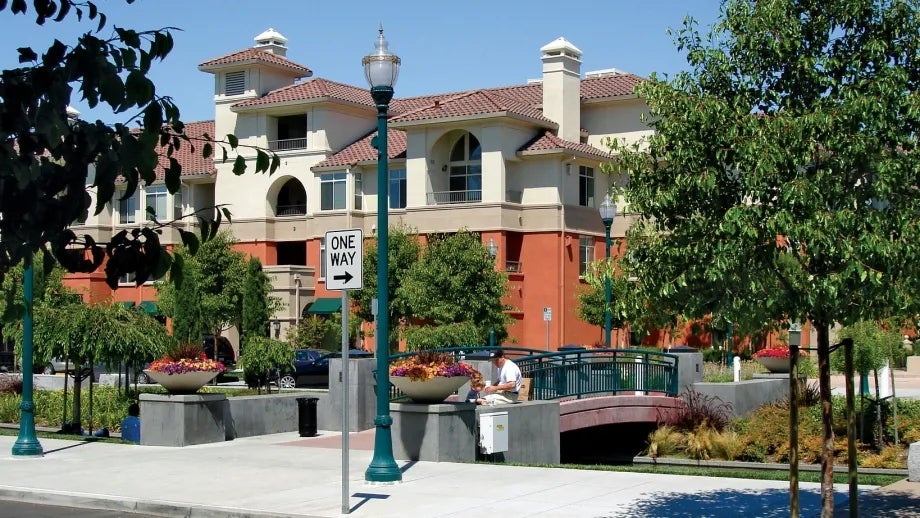Priority Development Areas (PDAs)
Priority Development Areas (PDAs) are places near public transit that are planned for new homes, jobs and community amenities.
By bringing transit, jobs and housing together in downtowns, along main streets and around rail stations, Priority Development Areas (PDAs) help the Bay Area reduce greenhouse gas emissions and begin to solve the region’s housing crisis.
PDAs increase access to housing, and economic and cultural opportunities — no matter a person’s race or income.
Since they are located in places with existing transit infrastructure, they make the most of public investments and limit development impacts on communities and the environment.
With a variety of options for getting around, PDAs enable people to live a car-free or car-light lifestyle.
Explore MTC’s open map of Priority Development Areas.
Priority Development Areas are just one part of the overall set of strategies that make up the Bay Area's long-range regional plan.
View resources for recipients of PDA grants.
Regional Growth Framework
The Bay Area is expected to be home to an additional 1.4 million households by the year 2050.
It is important that housing, transportation and other types of land use planning work together — as part of a regional growth framework — to create an equitable, prosperous future for all Bay Area communities and make the best use of available resources. PDAs are a key piece of the Bay Area’s regional growth framework.
How Does an Area Become a PDA?
PDAs are identified and planned by local governments. Cities and counties nominate areas to the Association of Bay Area Governments for adoption.
Bay Area local governments have established more than 200 PDAs since 2008. Through PDA Planning and Technical Assistance Grant programs, cities across the region have adopted plans for roughly 110,000 new homes and 200,000 jobs within walking distance of frequent transit service.
2023 PDA Applications Closed
The 2023 PDA application window to create new PDAs or change the boundaries of an existing PDA is now closed.
Two PDA Designations
There are two types of PDAs:
- Transit-Rich PDAs have high-quality transportation infrastructure already in place to support additional growth in their communities
- Connected Community PDAs offer basic transit services and have committed to policies that increase mobility options and reduce automobile travel
PDA Eligibility Criteria
All PDAs must meet the following criteria:
- Nominated by a local government with land use authority
- Infill location is fully contained within an existing urban area
- The plan for significant housing growth and/or housing and employment growth is reflected by the local jurisdiction’s general plan or zoning ordinance and must be completed by 2025
- Area been identified as a Transit-Rich or Connected Community
Below are additional criteria that apply individually to Transit-Rich PDAs or Connected Community PDAs.
Transit-Rich PDA Criteria
At least 50% of the area is within 1/2 mile of any of the following:
- An existing rail station or ferry terminal (with bus or rail service)
- A bus stop with peak service frequency of 15 minutes or less
- A planned rail station or planned ferry terminal (with bus or rail service) in the most recently adopted fiscally-constrained Regional Transportation Plan
Connected Community PDA Criteria
The entire area is within 1/2 mile of a bus stop with peak service of 30 minutes or less and is beyond 1/2 mile of transit service that meets the “high quality transit” criteria as defined above for Transit-Rich PDAs; and meets at least one of the following:
- At least 50% of the area is defined as a High Resource or Highest Resource on the most recent Opportunity Map adopted by the California Department of Housing and Community Development
- At least 2 policies have been adopted to reduce Vehicle Miles Traveled, such as prioritization of bicycle and pedestrian planning projects
MTC's PDA Planning and Technical Assistance Program helps local governments create Specific Plans for PDAs. Local governments can receive customized support for challenges such as establishing design standards or updating transportation impact review.
Plans funded through the program must be integrated into the local zoning code, be supported by a programmatic Environmental Impact Report (EIR), and address all of the PDA planning elements, which range from affordable housing to parking demand.
To review completed PDA or Station Area plans, search the Digital Library for "Completed PDA Plans."
To review earlier Technical Assistance Program commitments, search the Digital Library for “Completed PDA Technical Assistance projects.”
PDAs are an important part of Plan Bay Area 2050, the long-range regional plan that will help make the nine-county Bay Area a better place to live and work. Visit planbayarea.org to learn more about the plan.
MTC’s Transit-Oriented Communities Policy is part of the Regional Growth Framework, and is designed to align future housing growth with major regional transit investments.

